Are you a Quiet Speculation member?
If not, now is a perfect time to join up! Our powerful tools, breaking-news analysis, and exclusive Discord channel will make sure you stay up to date and ahead of the curve.
Burn in Modern has had its highs and lows. It has bounced between tier 1 and tier 2 for almost the entirety of the format, finally cementing itself as a tier 1 strategy as of late on the backs of new additions from recent sets. The deck is a combo deck that doesn't have a combo: its “combo” is counting to 20 quickly and efficiently. Seen as a "noob" deck due to its (usually) low cost of entry and barrier of play, its (mostly) non interactive nature has relegated it to the corner of the room with the likes of Bogles and friends.

While most of these opinions are half-truths, the deck has a lot of areas where you can squeeze out percentage points that put it further ahead of most strategies in Modern. Coupled with poor deckbuilding and weak card selection, this "easy" deck is often not played to its full potential. Having played Burn since the formats infancy, including several GP money finishes with it, I feel I can offer some deeper insight into an archetype that players often assume is far simpler than it actually is.
[wp_ad_camp_1]
Examining the List
Most players would assume a typical Burn list consists of only the lowest costed burn spells and most efficient, guaranteed damage creatures; it actually isn't that simple. Let's take a look at what I would consider the stock list:
Untitled Deck
I would be extremely hesitant to change anything in the main deck above. Let’s touch on some questions I've been asked about card choices and alternate options.
The Untouchables
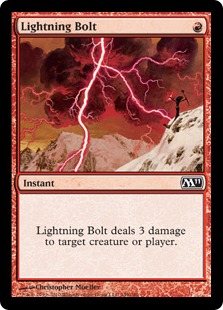 Lava Spike, Rift Bolt and Lightning Bolt are an automatic four-of. Lightning Bolt is the best burn spell printed, and its two friends are the closest we have come to replicating this in Modern. The same goes for Boros Charm and Skullcrack: Boros Charm being a rare two mana for four damage, and Skullcrack having the extremely helpful life gain prevention clause while maintaining a reasonable CMC-to-damage ratio. Searing Blaze is an absurd card when it is relevant. You will have some games where it is merely a two-mana/three-damage spell, but the risk/reward ratio is far too great to drop these down to less than three copies. As for the two flex spots, I usually lean towards Lightning Helix, but other options are available.
Lava Spike, Rift Bolt and Lightning Bolt are an automatic four-of. Lightning Bolt is the best burn spell printed, and its two friends are the closest we have come to replicating this in Modern. The same goes for Boros Charm and Skullcrack: Boros Charm being a rare two mana for four damage, and Skullcrack having the extremely helpful life gain prevention clause while maintaining a reasonable CMC-to-damage ratio. Searing Blaze is an absurd card when it is relevant. You will have some games where it is merely a two-mana/three-damage spell, but the risk/reward ratio is far too great to drop these down to less than three copies. As for the two flex spots, I usually lean towards Lightning Helix, but other options are available.
The creature suite is also near-unchangeable. Goblin Guide is absurd, and Monastery Swiftspear can do a very good impression. Eidolon of the Great Revel on turn two can sometimes do upwards of six damage in such a low cost-centric format. Grim Lavamancer fails the "always do damage" test, but its value against any creature decks, as well as providing "free" damage if he lives, warrants his inclusion.
Lands are a very important, and an often overlooked, part of Burn. A minimum of eight fetches is recommended: you need to be able to reliably fix your mana, provide fuel for Grim Lavamancer and have access to landfall whenever needed for Searing Blaze. If possible, play four Scalding Tarn. Leading with a Tarn, especially if you don't make a turn one play, can occasionally make your opponent put you on another deck and make incorrect plays.
The Cards That Didn't Make the Cut
I'm constantly asked about Vexing Devil. The second you give the opponent a choice, the card loses its potency. I don't want to be staring at a board full of creatures and draw a Vexing Devil instead of another burn spell; neither do you. Consistency is how we win.
 I have tested the Atarka's Command version extensively and have come to the conclusion that the upside of the card is not worth the mana issues it can cause. With such a low land count, Burn needs to be able to operate on two lands. Having to always fetch a Stomping Ground + Sacred Foundry immediately, while shocking yourself, opens you up to the same problem the rest of the format has: the amount of damage taken to fix your mana. While you gain percentage against many decks in the format, plus being Skullcrack five through eight, you open yourself up to losing to the other aggressive decks, and the mirror match becomes far worse. I feel the consistency of R/W outweighs the power level of this card.
I have tested the Atarka's Command version extensively and have come to the conclusion that the upside of the card is not worth the mana issues it can cause. With such a low land count, Burn needs to be able to operate on two lands. Having to always fetch a Stomping Ground + Sacred Foundry immediately, while shocking yourself, opens you up to the same problem the rest of the format has: the amount of damage taken to fix your mana. While you gain percentage against many decks in the format, plus being Skullcrack five through eight, you open yourself up to losing to the other aggressive decks, and the mirror match becomes far worse. I feel the consistency of R/W outweighs the power level of this card.
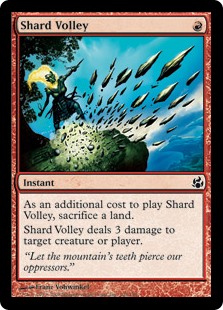 Shard Volley can easily be run in the flex spot, but I would caution against more than one. You want this to be the last spell you cast, outside of flooding scenarios.
Shard Volley can easily be run in the flex spot, but I would caution against more than one. You want this to be the last spell you cast, outside of flooding scenarios.
The inclusion of Flames of the Blood Hand was arguable before Skullcrack. Going forward, we have better, cheaper options.
Wild Nacatl is easily splashed, but it fails’s the Burn deck mantra – be outstanding or do guaranteed damage. While a 3/3 for one is good, it doesn’t always do damage and strains the mana base. Pass.
While the cost to damage ratio on Magma Jet is poor at best, the scry 2 changes a lot of things. The closest card we have to damage combined with card draw, scrying is still merely card selection. While not an awful choice, the card is really only great when you are scrying two unwanted Mountains to the bottom. It's inclusion is a debate that probably has no right or wrong answer. The consistentcy argument can go both ways in selection versus damage. My personal choice: I would be hard pressed to find cuts for it.
The Sideboard
Some of the biggest mistakes I see with the deck concern extremely poor sideboarding choices. When building a sideboard for a deck with such a consistent game plan, your first concern needs to be maintaining consistency. Sure, Path to Exile is great against Wurmcoil Engine, but when you side in four and see three in your opening hand, it starts to look pretty bad.
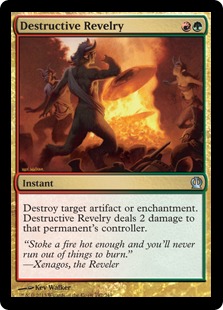 The cards in your board need to either continue your game plan (do damage to the opponent), fix a problem that is near impossible to beat (Leyline of Sanctity, Kor Firewalker), or give you the time you need to get enough draw steps to win. With that being said, outside of an extremely large metagame shift (or one where everyone plays Soul Sisters) , I would recommend the sideboard listed above.
The cards in your board need to either continue your game plan (do damage to the opponent), fix a problem that is near impossible to beat (Leyline of Sanctity, Kor Firewalker), or give you the time you need to get enough draw steps to win. With that being said, outside of an extremely large metagame shift (or one where everyone plays Soul Sisters) , I would recommend the sideboard listed above.
Destructive Revelry is the reason for the small green splash. Dealing with all of the problem enchantments, the plentiful Modern artifacts, as well as the damage bonus makes this an all-star in plenty of matchups. It's perfect sideboard material.
Kor Firewalker is me admitting the mirror match sucks. Whoever can keep one alive is usually a lock to win.
Path to Exile is your best removal against creatures that are innately hard to deal with. (Wurmcoil Engine, Deceiver Exarch, Kor Firewalker, etc.)
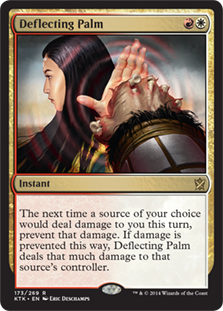 Deflecting Palm is my favorite “Oops, gotcha!” card. Amazing against Tron (targeting a desperate Wurmcoil attack is wonderful), Affinity, Infect, double-striking Primeval Titan, there are too many uses to list them all!
Deflecting Palm is my favorite “Oops, gotcha!” card. Amazing against Tron (targeting a desperate Wurmcoil attack is wonderful), Affinity, Infect, double-striking Primeval Titan, there are too many uses to list them all!
Relic of Progenitus may seem odd, but it can be a workhorse that will always replace itself. Shrinking Tarmogoyf, preventing early Anglers/Tasigurs, lowering Snapcaster’s value, and interrupting any other random graveyard based decks makes this a quiet all-star.
Rending Volley is a concession to Splinter Twin being a deck. Volley can be easily dropped if/when Twins metagame percentage drops, but it's a lifesaver in a lot of cases.
Other common sideboard cards I've tested include Molten Rain (great against Amulet but dangerous at three CMC), and Blood Moon (same problem: three CMC is worrisome). As always, board to your local meta, but I always think in terms of playing at a larger event.
Next Level Playing Tips
General Deck Tips
- Think in terms of draw steps: You win by maximizing the amount of cards you draw while your opponent can’t kill you. Practice calculating odds in your head. Always play to your outs and calculate the odds of drawing one out versus another based on how many draw steps you'll gain from each play.
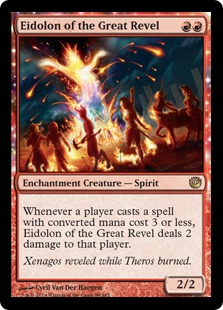 Sequence your spells properly: When possible, cast the most expensive spells first. Play Eidolon of the Great Revel as early as possible. Be careful you don’t Eidolon lock yourself against creature decks you can't attack into.
Sequence your spells properly: When possible, cast the most expensive spells first. Play Eidolon of the Great Revel as early as possible. Be careful you don’t Eidolon lock yourself against creature decks you can't attack into.
- Avoid the 'EoT' Trap: One of the biggest mistakes new Burn players make is believing that all instants need to be cast at the end of your opponent's turn. Instead, consider each specific scenario; I have no hesitation main phasing burn on my turn, if they are tapped out, to avoid countermagic.
- Mulligan aggressively: I always mulligan five (or more) land hands. I also mulligan four-land hands if I'm not on the play and don't have a turn one creature. I almost always keep one-land hands with at least one-two plays, especially on the draw. You have a roughly 60 percent chance to draw the second land by the second draw step.
- Identify your role early: Know when you are the beatdown and when you are the control deck. Against the hyper-aggressive creature-based decks (Affinity and Infect) you are almost always the control deck. They will run out of relevant creatures before you run out of burn.
- Be patient: If you have lethal, wait as long as possible without putting yourself in a position to lose. You don’t want to be the guy who bolted his opponent at 3 life only to see them Lightning Helix in response. Quoting the timeless D3: The Mighty Ducks – “Make him make the first move, Conway!”
 Play around Snapcaster: Against any Snapcaster decks, respond to a counterspell with additional burn spells while the counter is still on the stack instead of waiting for the counter to resolve. This avoids having the same counterspell "snapped back" at another of your spells. Dispel only costs one mana, so "four mana" could counter two spells if you walk into it.
Play around Snapcaster: Against any Snapcaster decks, respond to a counterspell with additional burn spells while the counter is still on the stack instead of waiting for the counter to resolve. This avoids having the same counterspell "snapped back" at another of your spells. Dispel only costs one mana, so "four mana" could counter two spells if you walk into it.
- Dodge lifelink: You can prevent lifegain from any lifelink creature by killing a blocker in response. Grim Lavamancer plus any other creatures can give you multiple turns of blocking a Wurmcoil Engine (it can even kill itself to buy more time).
- Accept the hate: Don’t get dejected when losing unwinnable games. Some people just hate losing to Burn and have upwards of eight sideboard slots against it. Take solace in the fact that they are sacrificing a large amount of other matchups to make this one better.
Single Card Tips
- Skullcrack (#1): The second text line is extremely relevant. 'Damage cannot be prevented this turn' allows your Goblin Guide to trade with an Etched Champion or Kor Firewalker blocking it.
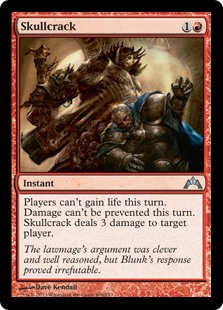
- Skullcrack (#2): If you suspect life gain effects, save your Skullcrack as long as possible. If you don’t have one, telegraph you do. Life gain can be the biggest swing against Burn. People really don’t want to walk Timely Reinforcements or Lightning Helix into Skullcrack. Even the fear of the card is enough to put them off a play long enough to swing a game in your favor.
- Eidolon of the Great Revel: Cast Eidolon pre-combat if you are attacking with a Goblin Guide and expect removal on it. This forces them to use it before getting a “free” Goblin Guide trigger.
- Searing Blaze: If you don't have a fetchland in play, hold lands in hand in case you need to trigger a Blaze.
- Boros Charm: Charm can be more than just four damage: the other modes can be relevant too. In rare cases, double strike can cause more damage or allow you to remove a problematic creature or blocker. The indestructible clause applies to ALL of your permanents. You can make your lands survive a timely Stone Rain effect that would cut you off a colored mana source you need.
Sideboarding Guide
Twin
This matchup is very skill intensive for both players. You need to apply pressure while holding back your burn in case you need to waste two spells on an Exarch. Do not tap out (or even come close to tapping out) if your Twin opponent has open mana. 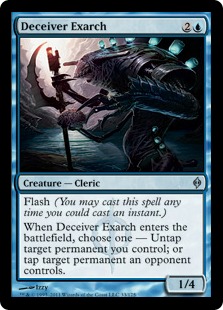 Always prepare for Dispel and try to hold up your cheapest spells that can target a creature in case they go for it.
Always prepare for Dispel and try to hold up your cheapest spells that can target a creature in case they go for it.
OUT
Skullcrack
IN
Rending Volley
Destructive Revelry
Watch out for Batterskull post-board. Path to Exile can be brought in if you feel they are still on the combo plan. Feel free to bring in more Revelry if you see Spellskites. Never trust that one removal spell, for a creature or an enchantment, will be enough.
Grixis (Delve or Twin)
Grixis is a very good matchup for Burn. Eidolon is a house, their manabase is painful, and early creatures keep them off great mana-fixing options.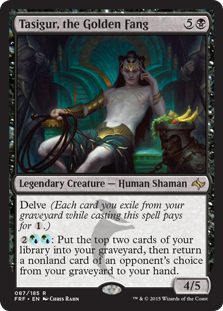
OUT
Rift Bolt
Searing Blaze (if no Delver)
IN
Relic of Progenitus (if Delve)
Rending Volley (if Twin)
Destructive Revelry (if you expect Dragon's Claw)
You lose this matchup to an early delve threat you can’t answer. Relic keeps them off early creatures as well as downgrading Snapcaster into an Ambush Viper. Cash it in when you need the card or to keep them off certain cards in the yard.
Jund/Abzan
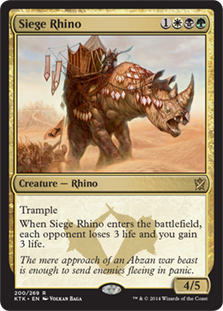 Early Tarmogoyf into Siege Rhinos are how you lose this matchup. Keep up Skullcrack whenever possible, and watch how you play Eidolon of the Great Revel. Eventually you can get locked out of playing anything when they start chaining Rhinos and swinging with manlands.
Early Tarmogoyf into Siege Rhinos are how you lose this matchup. Keep up Skullcrack whenever possible, and watch how you play Eidolon of the Great Revel. Eventually you can get locked out of playing anything when they start chaining Rhinos and swinging with manlands.
OUT
Eidolon of the Great Revel (on the draw)
Lava Spike/Rift Bolt (on the play)
IN
Deflecting Palm
Relic of Progenitus
On the draw, Eidolon is often too slow to do any good. Once a 3/4 Goyf hits the board, Eidolon is stonewalled and you are looking at having to waste it plus a burn spell to get Goyf off the board. It's enchantment type is also another card type to make Goyf larger. Relic shrinks Goyf and takes away the value of Lingering Souls.
Burn
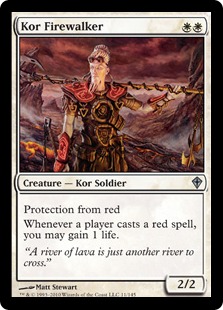 Whoever draws better will usually win this awful mirror match. On the bright side, you'll have time to get lunch.
Whoever draws better will usually win this awful mirror match. On the bright side, you'll have time to get lunch.
OUT
Eidolon of the Great Revel
IN
Deflecting Palm
Kor Firewalker
Path to Exile
Kor Firewalker is the trump: landing one is usually enough to win and two is near unbeatable. Path to Exile is the answer to Firewalker; don’t be tempted to waste it on anything else.
Affinity
OUT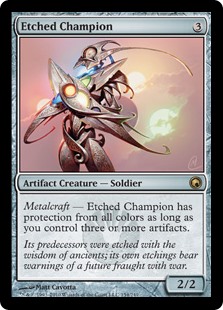
Eidolon of the Great Revel
Lava Spike
IN
Destructive Revelry
Deflecting Palm
Eidolon is awful against a deck that pukes out its hand, so don’t make the mistake of leaving them in. Searing Blaze and Destructive Revelry will put in a ton of work. Save Skullcracks for Vault Skirges. Palm can stop a huge plating swing, but watch out for the instant speed equip.
Infect
IN
Path to Exile
Deflecting Palm
Destructive Revelry
You are not the beat down here: cast your removal on your turn, sandbag as many targeted burn spells as you can, and grind them out. They will run out of creatures before you run out of burn spells.
Amulet Bloom
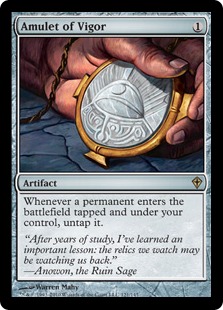 OUT
OUT
Searing Blaze
Grim Lavamancer
IN
Destructive Revelry
Deflecting Palm
Arguably Burn’s hardest match up, this is "two ships passing in the night". You need to race as hard as possible and don’t look back. If you can blow up an Amulet quickly, snap it off. Deflecting Palm can fling a giant Titan attack back at them, just be prepared for Pact of Negation. Save your Skullcracks and watch out for Thragtusk after boarding.
GR Tron
OUT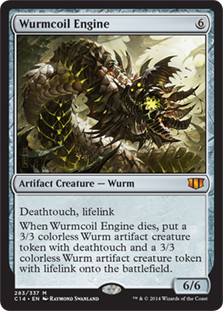
Searing Blaze
IN
Destructive Revelry (on the play)
Path to Exile
Deflecting Palm
A great matchup for Burn: you should beat them with all but the slowest hands. The only worries are a turn three Karn Liberated or Wurmcoil Engine. Path answers Engine or Deflecting Palm buys you a turn plus a huge damage swing. Bring in Revelry on the play to occasionally catch an Expedition Map before they can search or to blow up Spellskites.
Conclusion
Once you are running an efficient list, you can gain the most percentage points against the field by playing the deck to near perfection. Sequencing, calculating odds, and knowing exactly how to play around cards gives the Burn pilot tons of room for growth. Learn the format; learn your cards; and pounce on mistakes, misplays, and stumbles. When played to near perfection, Burn is one of the least variance-affected decks in the format – a very attractive prospect to long-term winning percentages. Plus, who doesn't love a turn one Goblin Guide?


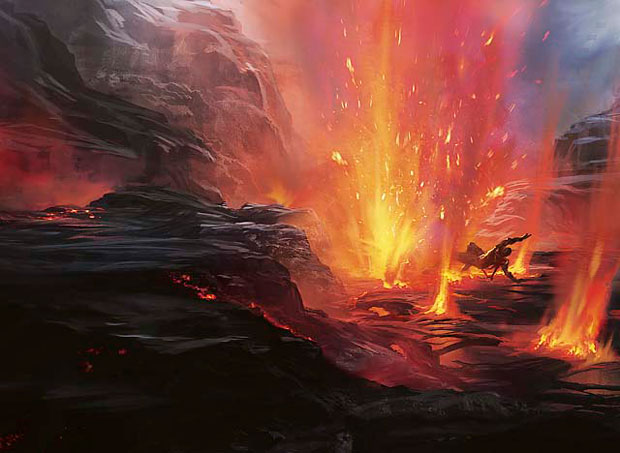
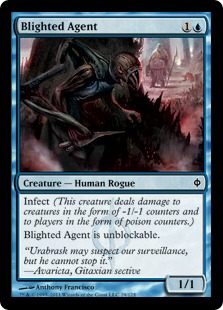


Great job! This aticle really will help me to the GPT Porto Alegre this weekend. Thanks!
I overall, you covered the basics of burn. I disagree heavily on the account of not running atarka’s command. In my opinion, the games I lost were not because of the second fetch shock it was more related to the matchup in general, or lack of spells at all. Atarka’s command has made the difference one to many times for me to justify cutting it. I’d say 1/15 games I have mana issues, and that is a number I am willing to accept.
I am currently testing out nacatl. There are pros and cons to it and we shall see where it takes me.
Some of your side boarding tips seem a bit weird, but I suppose some of that is my opinion and is subject to change. How do you usually justify taking out lava spike?
1/15 games is less then I believe it is, but even with that assumption, I feel is an unacceptable sacrifice to make. Burn’s best attribute is it’s consistency, and when you even sacrifice a little of it, you lose those small points that can consistently put burn ahead of most decks.
Outside of the more damage to yourself and fixing issues, you also open yourself up to land removal (Ghost Quarter is played quite a bit lately.) In testing I found myself staring at a handful of gold cards on only mountains when this happened, which to me is unacceptable. I feel like the slightly lower power level of not running it is more then made up by the consistency.
Lava Spike comes out against infect as you can’t target creatures with it – in that matchup (as well as affinity) you are the control deck.
Some valid points. on your reddit post someone mentioned that they are in a very heavy grixis and control meta (same for me) so i suppose that is why atarka has been doing so well for me.
Could you please give me an in-depth “how to fight any variant of the UXx shell ” how to? One of my worst matchups usually.
http://www.starcitygames.com/article/27944_Burn-vs-Counters.html
I believe this article gives a decent outline of playing against blue counter decks. It isn’t Modern Burn specific, but might still be of sone use to you.
I can definitely attest to winning quite a bit of match ups against burn because I ghost quartered a land they needed for one or more spells in their hand. That gave me the precious extra turns I needed to race them back. It’s definitely a weakness of the Atarka’s command deck, at least from an opponent’s perspective
Great article. It helped me alot! I am still very torn about atarka’s command, there are some matchups when it’s handy to have more options (land drop in response to land removal, damage through Leyline of Sanctity) . I would love to hear Your an opinion about Leyline of Punishment or black splash 🙂
Leyline of Punishment is too narrow to play. You only really would want it against decks bringing in 8+ lifegain cards against you, and you probably still aren’t winning that game. You also have to run 4 copies to have the best odds of opening with one, and getting to 4 mana to cast is doubtful.
Black splash is sadly strictly worse then the white or green. While Bump in the Night and sideboard options are great, the power level isn’t as high comparatively.
I’m with Nate. I think you did a decent job explaining Burn in general.
That being said, there are a lot of odd things I’ve read that may need touched on. Things like your Atarka’s Command evaluation. I too was highly skeptical of it when released. I didn’t think the green splash was worth it…until played. The fact this offers Burn a T3 win is absurd. It also gives you options. Having options is always a plus side to any card. The hit to your mana base will rarely matter as it gives you an extreme tempo boost to make up for the loss of life.
I would also highly disagree with Relic in the sideboard. You preach about not straying away from the plan, but that is exactly what this card does. The threat of shrinking a Goyf can be real., but in the end, you’re still racing it/other threats. With that, our sideboards are similar.
Mine is -2 Relic, -1 Path, +1Palm, +2 Exquisite Firecraft. Which is a real card in today’s metagame.
Lastly, your sideboard ing guide is a…decent start. It does need a lot of work though. Rift Bolt should come out always before Spike. I don’t see a reason for spike to ever come out actually. Eidolon comes out almost always on the draw. Point being, you have to go super deep into side boarding because of how much it plays into your decision making.
I enjoyed the article though despite these disagreements. I hope to see you reply, if not to me, to the others on here. Love getting new opinions, and debating on why they’re bad/good.
Hey! I stand by my Atarka’s Command evaluation from lots of testing I’ve done. I’ve had a few turn 3 wins, which is great, but I’ve also had multiple games I (arguably) lost because I had to take 6 damage off of my lands turns 1-2. This debate probably has no right or wrong answer. I feel consistency is the best thing burn has going for it, and I don’t like sacrificing that (especially in the already awful mirror match).
Relic does exactly what the deck’s plan is – giving you more draw steps. Be it by slowing down delve (a turn 2-3 tas or Angler is actually a real clock against us with counterspell backup), shrinking goyfs (goyf into goyf is also a real clock that this straight up stops in its tracks). Basically, relic gives you more turns to win races when you draw poor AND always straight up replaces itself.
I also disagree on the rift bolt before spike. Rift bolt is more relevant in a few key matchups. Against infect/affinity it targets creatures (again, you are the control in these games). I would only go the other way against decks with spellskite as it can’t be redirected. As for Eidolon, I dont like to make any sweeping generalizations. It stays in on the draw in multiple matchups ( I just didnt touch on many of the tier 2 decks).
Thanks for the comments!
Can you explain how Firecraft is a real card?
The biggest reason I play it in my board as a 2x is the term “Spell Mastery.”
It is quite the finisher against all the Snapcaster decks, and Merfolk, which has seen an increase in play. I had it as a 1-of in my side, but immediately bumped it to 2 after seeing it in action. If you expect a lot of Dispel-esque, and Merfolk decks, I would try it out.
It’s articles like these that make me consider just taking the dive and being ‘that guy’.
Currently on Twin, but there’s something about just burning someones face off that seems rather beautiful 😛
I suppose you become the person to ask now – how do you beat Burn (specifically as RUG Twin)?
RUG Twin should have a better time against Burn than the other Twin variants, specifically because Goyf is such a house in the matchup. Feed-Snap-Feed doesn’t hurt, either.
RUG Twin doesn’t run Feed the Clan – mostly because Ferocious is unreliable in a deck with only Tarmogoyf to turn it on.
Thragtusk + Huntmaster of the Fells is the life gain (Huntmaster pre-board).
Dispel, Snap, Dispel is the best thing in the deck I’ve found. But I was wondering if there was something else I was missing.
I’d highly encourage running Feed the Clan as a 1-2X vs burn if you find the match-up at all challenging. It is way more effective than any sorcery speed lifegain, as burn can almost never afford not to tap out at some point during the game (where as burn often can hold up one or more skullcrack type effects). Even using it for 5 life is often enough to win the game, and with Goyf you should have a decent chance of triggering for 10. Again, even without ferocious, a feed snap feed for a total of 10 lifegain is virtually unbeatable.
Seems unfair to Wild Nacatl. It’s putting up more and more results in Modern Burn decks and you didn’t touch on the whole point of the card – that it truly shines in creature-light metas.
Depending on what other people are playing, it can actually be wrong not to run Nacatls in Burn. Obviously, the Nacatl/Atarka Burn deck is a different build, and Nacatl doesn’t just “fit in” to the flex spots of a more cookie-cutter list. But I would like to have seen it addressed or acknowledged at the very least. Instead, you dismissed Wild Nacatl by calling it “good” but not “outstanding” and claiming it doesn’t fit into the Burn deck, which recent results have indicated is just false.
Some Nacatl Burn lists and info, for reference:
http://www.mtgtop8.com/event?e=10024&d=257846&f=MO
http://www.mtgtop8.com/event?e=10024&d=257849&f=MO
http://magic.wizards.com/en/events/coverage/gpcha15/modern-history-2015-06-13
http://www.channelfireball.com/articles/what-i-played-and-what-i-should-have-played-in-charlotte/
Plenty more can be found just by Googling around the web, including more finishes and big discussions on Reddit and MTGSalvation.
Can you link me more info on it? I have read everything i could on it and want to learn more.
I feel like you are moving towards more of a zoo deck when you add Nacatl’s, which is outside of the philosophy behind burn. Off the top of your deck, Nacatl does nothing. Having it in your deck lowers the consistency of the deck (a point I’m making throughout the article). To me, the power level of all of these cards do not equal the power level of being the most consistent and least affected by variance.
As for the the lists, I’m sure for every green splash Nacatl list, you could find a list without them, or straight R/W, or some other build. Doing well with a card in the deck doesn’t mean it IS good in the deck. I could put 4 shocks in the deck and probably win a few dailies. You don’t get to see every Nacatl list that lost when they drew it instead of a bolt 🙂
Thanks for feedback!
Excellent primer. As most of the others on this comments thread, I don’t quite agree with everything you’ve said on the deckbuilding side (I swear by Atarka’s Command, it’s been amazing), but everything is well-reasoned and backed up by experience, which is nice. Your tactical notes I agree with almost to the letter.
However, I am a bit curious as to why you chose Path to Exile over Pyrite Spellbomb as your tool of choice to deal with the likes of Kor Firewalker, Master of Waves, and Auriok Champion. Doesn’t an answer that gives you the option to cycle it or use it to fulfill your prime directive (count to 20) profile as a better choice? It also answers Etched Champion as a bonus.
Lastly, I wanted to ask if you had considered testing Day’s Undoing. It makes the mana base all sorts of complicated (unless you cut green), but the prospect of Burn refueling its hand is pretty scary for most opponents. What say you?
Thanks!
I should have mentioned Pyrite Spellbomb – up to a few weeks ago that’s exactly how my list was – (bombs for paths). My biggest problem was that quite a few Tron decks had popped up, and a turn 3 Wurmcoil (while able to be played around) is much easier to just path.
The second problem is that in the mirror match, players who run atarka’s command can protect the firewalker by +1+1’ing his team when you crack the spellbomb.
I’ve tested Day’s Undoing off and on – I really can’t decide how I feel. 3 mana is worrisome, and you need to have emptied your hand to get the most value. I feel like it doesnt fit in, but that could be wrong!
I guess Tron is a bit of a problem for Pyrite Spellbomb, but isn’t that a matchup that you stomp anyway? I freely admit I don’t give Tron a whole lot of thought as Burn, because I figure if all goes well for me, it’s an easy W.
As for Day’s Undoing… Yeah, I’m not entirely sure if this is the right deck for it, but I figured it was worth a shot. It’s worked decently, but I decided to keep all 4 colors and sometimes you take a lot of damage yourself. It may not be worth it, but I need to gather more data (and opinions) to be certain.
It is a very good match up, but I don’t have a problem making it better! It’s also just better in general, against twin, ect. As well as getting around the atarka’s command to save a firewalker!
Exactly. My initial testing found it not so great, but it needs to be tested in a far larger amount of games then I did.
Path to Exile is also one burn’s few outs to Tasigur/Goyf/Gurmag Angler. Those creatures brick burns creatures so hard and having a one mana answer that is also relevant in other match ups (Tron, mirror, merfolk) seems better than Pyrite which has much more limited applications.
Really nice article!
Some thoughts as a non Burn player (but I played a ton against it):
Command shines in a creature light meta. The same is true for Nacatl. Both cards benefit a ton, if the opponent has no reliable access to an early blocker such as Goyf/Tas/Nacatl. Thus, you can deal more damage with your creatures without losing a lot.
However, if your meta has more creatures decks in it, both cards get a lot worse. Most of the times, the creatures deck are either aggro decks or some kind of combo (something like Zoo, any form of CoCo, Meerfolk,…). Against those decks, both cards (so Nacatl and Command) are bad.
Furthermore, I saw several times, what burn loses with the G splash, namely a ton of consistency. Many of my opponents lost, because they couldn’t cast their spells. But I still think, that Naya burn is the better deck in creature light metagames.
Funny enough, one of the best creatures against burn is Wild Nacatl, since he kills every single creature and you need to waste burn on him. He is one of the reasons, why Zoo has such a good burn match-up (at least from my experience).
Greetings,
Kathal
PS: What do you think about a RG Burn deck? Saw some of those running around, but I don’t like the lose of both SB options and Helix/Charm.
Loosing boos charm is too damning imo. I tried Jund. It didn’t work.
Hey WIll! I was wondering if you could explain why you decided to go with 20 lands instead of 18 or 19? It seems like the average burn deck contains 19 lands, with 9-10 fetches. I know in many decks the difference between an extra land might seem trivial, but in burn I feel the difference can be significant. For example, running a single Shard Volley as a late game bomb instead of the 20th land. Thank you for explaining, and great article! I completely agree with Atarka’s Command doing more damage than it is worth, as we end up burning ourselves way too many times in the end just by fixing mana. This was the whole reason I initially played two color burn decks.
Honestly, 19 versus 20 lands is totally personal preference. When you really break it down we are talking about something that will affect you 1 percent of the time, roughly. Personally, I find 20 lands the more comfortable place to be, as outside of drawing very well, you do want to see 2-3 land a game.
Thanks for the feedback! I definitely find that with the uptick of merfolk and affinity the 3 color’s in the main does us more harm then good, but as always you must play to the meta.
I’ve found atarka’s commands to be phenomenal. They are too good to pass on for me. My list is here (http://tappedout.net/mtg-decks/severely-burnt-queso/) for reference. I tested nacatl for a month, and found it underwhelming. Just my opinion though.